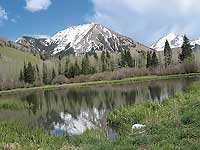 A summer paradise of luxuriant green meadows, aspen leaves gracefully playing in the breeze, the heady rush of mountain streams and wildflowers galore - all this and so much more is less than an hour’s drive away. That’s all the time it takes to migrate 6,000 feet to the blessed coolness of the La Sal Mountains, where the lure of the high country calls me back once again.
A summer paradise of luxuriant green meadows, aspen leaves gracefully playing in the breeze, the heady rush of mountain streams and wildflowers galore - all this and so much more is less than an hour’s drive away. That’s all the time it takes to migrate 6,000 feet to the blessed coolness of the La Sal Mountains, where the lure of the high country calls me back once again.
For thousands of years Native Americans made this seasonal upward migration for hunting and gathering purposes. That influence is reflected in the naming of Tomasaki Peak and Mount Waas after two Ute leaders. Tradition also suggests that the translation of Tukunikivatz is “place where the sun lingers longest” – an appropriate term for one of our more prominent peaks.
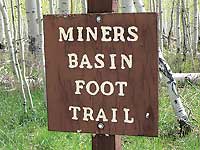 For my first outing I’m heading to Warner Lake where I always enjoy the impressionistic reflection of Haystack Mountain in its clear blue water. Taking a deep breath I suck in that refreshingly earthy, pine-scented air while savoring the sight of a huge grove of barely-leafed-out aspens that extend their white-barked arms up to a crisp azure sky.
For my first outing I’m heading to Warner Lake where I always enjoy the impressionistic reflection of Haystack Mountain in its clear blue water. Taking a deep breath I suck in that refreshingly earthy, pine-scented air while savoring the sight of a huge grove of barely-leafed-out aspens that extend their white-barked arms up to a crisp azure sky.
According to excerpts from the histories of George A. Day and Eli Day, published in volume 41 of the Canyon Legacy, this location was originally called “The Upper Place.” Around the turn of the twentieth century Herbert Day, his wife Mary and their twelve children lived here in the summer. This location provided abundant grazing for their dairy cows, as well as a market for their products to residents at Miners Basin, Gold Basin and also to the stockmen who worked in the mountains. In the winter they moved down to the “Lower Place,” currently known as Wilson Mesa.
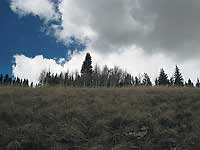 Herbert Day and the older boys built the dam and ditch for their irrigation system on Wilson Mesa, but ironically Warner Lake was named later on after a forest service ranger. Abandoned in 1912 nothing remains of the original homestead, except the lake, dam and ditch, which the Civilian Conservation Corps rebuilt in 1933.
Herbert Day and the older boys built the dam and ditch for their irrigation system on Wilson Mesa, but ironically Warner Lake was named later on after a forest service ranger. Abandoned in 1912 nothing remains of the original homestead, except the lake, dam and ditch, which the Civilian Conservation Corps rebuilt in 1933.
To get to Warner Lake from Moab go south on Highway 191 for approximately eight miles before turning left at the sign for the Ken’s Lake-La Sal Loop Road. Then go right on to Spanish Valley Drive, which quickly becomes the La Sal Loop Road. After a 14 mile drive turn right at the sign for Warner Lake. The five mile dirt road to the lake can be a jouncy ride over the washboard surface, but is still suitable for any vehicle.
Warner Lake, at 9400 feet, is the hub for a series of trails and I opt for the less traveled, least snow-covered Miners Basin Foot Trail – a three mile route that ends at Miners Basin. After starting at the billboard I pass through two gates and then quickly go right on to a dirt road. Immediately after that I take a sharp right at a sign with an arrow for a hike filled with more excitement than I bargained for.
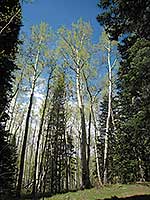 Before long I’m cranking up for the serious upgrade ahead through thick branches of Engelmann spruce and firs. In the alpine morning coolness the serenade goes on and on: ruby-crowned kinglets boisterously voicing their jumbled but distinctive song - the jack hammering of a woodpecker – the powerful voices of small elusive warbling vireos – all of it mingling in with the ethereal fluted chorus of the hermit thrush.
Before long I’m cranking up for the serious upgrade ahead through thick branches of Engelmann spruce and firs. In the alpine morning coolness the serenade goes on and on: ruby-crowned kinglets boisterously voicing their jumbled but distinctive song - the jack hammering of a woodpecker – the powerful voices of small elusive warbling vireos – all of it mingling in with the ethereal fluted chorus of the hermit thrush.
Above the banks of a gentle stream I skirt around the few remaining patches of snow to the only stream crossing on this route. Then, passing by a slope of jumbled loose rock called scree, I hear a pika - also known as the “whistling hare” due to its high-pitched alarm call. These resourceful animals, closely related to rabbits, do not hibernate. Instead during the brief summer they gather green plants and grasses to be dried and then stored in their burrows to sustain them through the winter.
At an aspen-lined meadow, the sign – right for the Mountain View Trail, left for the Miners Basin Trail - is missing. To avoid most of the snow I choose the left fork to start a long series of switchbacks through the aspens. At this point I’ve covered a fair distance, but I still have a long way to go to obtain the pass – my goal for the day.
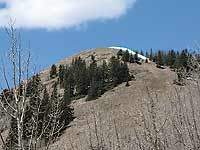 After the first switchback I pause to look over a fallen-down log cabin and the diggings of a small probably unproductive mine. If the remnants of this abandoned dwelling could talk, what tales they would tell of a boom that lasted just ten years (1897 to 1907) – the hopes and dreams of striking it rich –- the frantic backbreaking work through the short window of summer – and the heartbreak of coming up empty. They would also speak about the peaceful alpine beauty - the loneliness and isolation of being so far from civilization – the occasional trip to Miners Basin for supplies, the only nearby town where plenty of saloons could slake a miner’s thirst – and the long cold winter when deep snow pushed all inhabitants to lower elevations until the next mining season began.
After the first switchback I pause to look over a fallen-down log cabin and the diggings of a small probably unproductive mine. If the remnants of this abandoned dwelling could talk, what tales they would tell of a boom that lasted just ten years (1897 to 1907) – the hopes and dreams of striking it rich –- the frantic backbreaking work through the short window of summer – and the heartbreak of coming up empty. They would also speak about the peaceful alpine beauty - the loneliness and isolation of being so far from civilization – the occasional trip to Miners Basin for supplies, the only nearby town where plenty of saloons could slake a miner’s thirst – and the long cold winter when deep snow pushed all inhabitants to lower elevations until the next mining season began.
At the second switchback the aspens open up for a stunning, far distant view – a long stretch of canyonlands shimmering in the heat clear to the western horizon, where darkening clouds are building. And I wonder – Will they bring rain? As it turns out that will be the least of my worries.
 After 1.5 miles of a seemingly never ending uphill grind – Gold Knob finally pops into view. Topped with only one small patch of snow, already it is climbable, but the weather is too uncertain - I’ll try that some other day.
After 1.5 miles of a seemingly never ending uphill grind – Gold Knob finally pops into view. Topped with only one small patch of snow, already it is climbable, but the weather is too uncertain - I’ll try that some other day.
From here the pass is only a short distance away, and crossing a big sloping meadow – there it is. But alas my favorite sitting spot is buried in snow. At 10,840 feet everything is still hunkered down waiting for the kiss of the summer sun. I continue a little further on the ridge to a hidden dry spot in the trees anticipating a long relaxing lunch.
Just barely getting comfortable I hear a lot of crashing below. And then suddenly a panicked elk gallops straight toward me. I yell out “Whoa!” But he keeps charging! Not until the last possible moment does he veer, missing me by a few feet! Wow that was a close call, much closer than I ever dreamed could possibly happen and still leave me intact!
After that little drama, I am very ready to relax and soak in the special charms of the high country. But not for long - the ponderous thunderheads are growing and growing. The sun disappears making it eerily dark. An ominous chill fills the air. The wind kicking up its heels sends a strong signal to depart. But barely having caught my breath I’m not ready to leave. It’s the crash of thunder that finally convinces me not to press my luck any further. I’m heading for safer ground, wasting little time to do so!